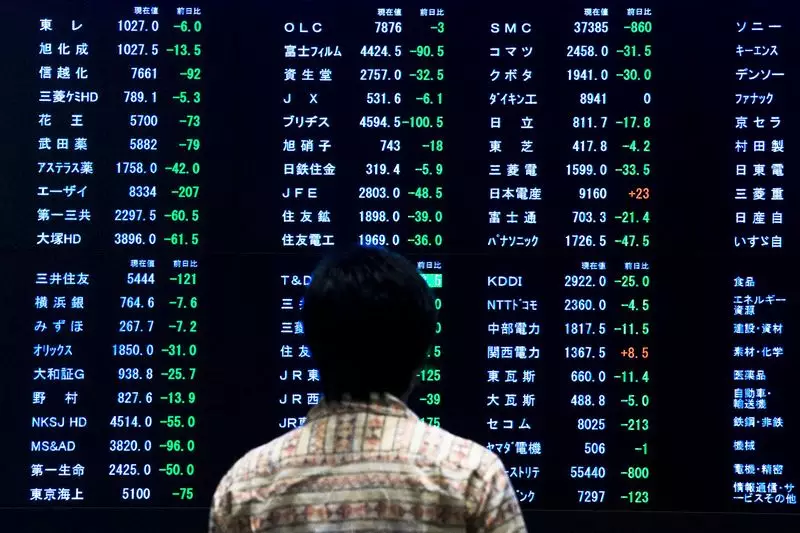On the vibrant and unpredictable stage of international finance, the ripple effects of monetary policy decisions in one region can significantly influence market sentiment across the globe. Recently, the Federal Reserve’s announcement of a significant interest rate cut by 50 basis points ignited a wave of optimism on Wall Street, leading to record highs for major indices like the S&P 500 and Dow Jones Industrial Average. This exuberance was mirrored in the Asian markets on Friday, albeit with a few notable exceptions, reflecting the complex interplay between local economic conditions and international monetary policy.
While many Asian stocks surged in response to the Fed’s decision, not all markets reacted uniformly. Japan’s Nikkei 225 emerged as the standout performer, achieving a remarkable 1.8% increase. However, this surge was moderated by the Bank of Japan’s (BOJ) decision to maintain its interest rates at their current level. The BOJ’s announcement, anticipated by market participants, included projections of rising inflation, emphasizing a cautious yet optimistic outlook for Japan’s economic recovery. Yet, the initial enthusiasm was tempered as investors digested the implications of the BOJ’s stance on future monetary policy, particularly with inflation expected to rise due to improvements in consumer spending.
Conversely, Chinese stock indices such as the Shanghai Shenzhen CSI 300 and the Shanghai Composite did not share in the excitement, declining slightly as investors grappled with the People’s Bank of China’s (PBOC) decision to keep its benchmark lending rate unchanged. Despite an environment ripe for monetary stimulus, the PBOC’s hesitancy underscored ongoing concerns over China’s economic slowdown, characterized by tepid consumer spending and persistent deflation. This divergence highlights the complexities facing Chinese policymakers as they navigate fiscal challenges and the urgent calls for fiscal intervention.
One of the key drivers propelling Asian markets upwards was the robust performance of technology stocks, which became a beacon of growth amid fluctuating sentiments. The gains were felt across the region, with notable advancements in Hong Kong’s Hang Seng index rising 1.3% due to bullish sentiment in tech sectors. Similarly, South Korea’s KOSPI index followed this trend, climbing by 0.8%. The correlation between U.S. technology performance and Asian markets reiterates the increasing integration of global finance, where technology remains a frontrunner in shaping economic narratives.
In addition to these gains, broader Asian markets benefited from the promising atmosphere created by the Fed’s decision. Investor sentiment was buoyed by the prospect of greater liquidity flowing into risk-driven ventures as looser monetary conditions create favorable opportunities for investment. Australia’s ASX 200 also demonstrated this dynamic, posting a modest 0.3% increase and achieving a record high earlier in the day.
While reactions to external influences like the Fed’s rate cut played a significant role, it is essential to recognize that domestic economic policies also heavily impact market performance. For Japan, the BOJ’s cautious outlook and its implications for rising consumer inflation lend credibility to the belief that the nation is on a tentative path to recovery, although the road remains fraught with challenges. The slight uptick in Japan’s CPI inflation, noted as reaching a ten-month high, serves as a testament to this improving sentiment, albeit under a tightrope of inflationary pressures.
On the other hand, the situation in China appears more precarious. With the PBOC’s avoidance of rate cuts despite severe economic headwinds, market analysts are left contemplating the long-term effects on China’s economic recovery. The lingering uncertainty surrounding consumer power and deflation casts a shadow on potential growth, prompting concerns among investors and economists alike.
As Asian markets rally in the wake of favorable U.S. monetary policy, a delicate balance must be maintained. Global investors will be closely monitoring not only the performance of regional stock indices but also domestic economic strategies that will serve to bolster or stifle growth. The importance of localized fiscal policies cannot be overstated; they will likely determine how effectively regional markets can ride the wave of optimism sparked by international developments. The weeks ahead will be pivotal as markets continue to adapt to both external influences and internal challenges, each shaping the intricate tapestry of economic progress in Asia.

